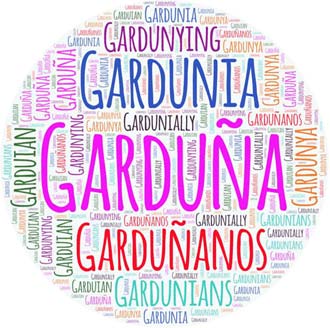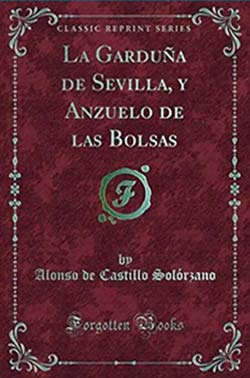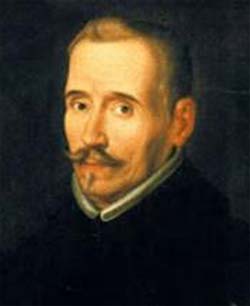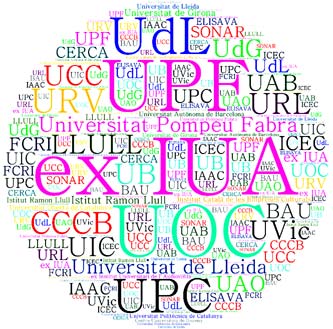| Pirating | Pirateando | Pirating | Barcelona, Catalunya - Spain :: Bergamo, Lombardia - Italy

:: FORMACION :: TRABAJO :: SANIDAD :: VIVIENDA :: INMUNIDAD LEGAL :: MITOS Y REALIDADES :: TENDENCIAS EN EL FUTURO A CORTO Y LARGO PLAZO :: NOTICIAS QUE IMPACTAN EN LA VIDA COTIDIANA :: FACTOR GARDUÑA
|
|
| El portal con verdades europeas :: La Garduña :: The Gardunia | ||||||||||||||||||||||||||||
Spanish :: English Una de las maneras más simple para abordar temas complejos es recurrir al diccionario para establecer con precisión la relación entre significante y significado de las palabras claves que componen la temática a tratar, y siguiendo las nociones básicas de la lingüística saussuriana. En nuestro caso el término es “la garduña”. Asociado a esa noción es interesante tener en cuenta las referencias geográficas, como son los nombres de ciudades, regiones, montañas, ríos, etc., los adjetivos y sustantivos que pueden hacer referencias a las cualidades positivas o negativas de seres vivientes o entidades abstractas; aspectos sociológicos, psicológicos, antropológicos, pedagógicos, etc.; comportamientos y acciones de esos entes reales o abstractos, como así también, el variopinto conjunto formado por artes, oficios, objetos, entre otros. Este es el motivo por el cual en el texto se irán destacando con cursiva y en negrilla, algunas palabras. Todavía en el siglo XXI, existen varias modalidades de diccionarios en soporte papel. Aquel en donde todo es texto y las palabras se listan alfabéticamente con sus correspondientes significados. En otros casos, están los diccionarios ilustrados, en donde los términos suelen estar acompañados, de manera total o parcial de figuras, tales como: Dibujos, pinturas, fotografías, reproducciones en 2D y/o 3D realizadas con el ordenador, etc. Estos diccionarios analógicos, a finales del siglo XX fueron digitalizados en soportes de multimedia off-line y online. En nuestros días, si buscamos la definición de “garduña” en diccionarios online, que oficialmente representan los principales idiomas, tales como el inglés, francés, español, portugués, italiano, alemán, ruso, árabe, chino, japonés, hindú, entre otros tantos, tan solo en el Diccionario de la Real Academia Española - DRAE [1], encontramos varias acepciones a dicho término y que son las siguientes:
Con referencia al animal tenemos otra definición online que dice: "Mamífero del orden de los carnívoros, de unos 70 cm de longitud (cola incluida), cuerpo alargado muy flexible, patas cortas, cabeza pequeña, hocico afilado, cola larga, y pelo suave y espeso de color marrón grisáceo con una mancha blanca en el pecho y el cuello; se alimenta de roedores, aves y frutos, y vive en bosques y lugares rocosos de Europa y Asia. La definición concluye con la siguiente afirmación “la garduña caza muchas veces animales domésticos, saqueando los gallineros”.
La garduña: Mamífero carnívoro que pertenece a la familia de los mustélidos. Coloquialmente se la puede definir como una loba o un lobo de escasa dimensión, con piel de cordero.
En otras palabras y desde el punto de vista de la zoología es un mamífero carnicero, de pelaje espeso y suave, muy estimado, y tiene dos sinónimos: cebellina y fuina. La marta cibelina o cebellina, cuyo nombre científico es “Martes zibellina”, tiene como sinónimo: Fuina (Martes foina). Es decir, un mamífero carnicero de la familia de los mustélidos, algo mayor que la comadreja. Algunas fuentes la diferencian de la garduña, diciendo que esta posee una mancha triangular de color naranja en la garganta. La palabra proviene del aragonés fuina, y éste del latín fagina, de fagus, haya. Los machos son más grandes que las hembras ya que llegan a un peso de entre 1,2 a 2 kg., mientras que las hembras de entre 0,9 y 1,5 kg. En el renacimiento, Leonardo Da Vinci, pintó en Milán, entre 1489–1490 a "La Dama del Armiño” (en italiano, La dama con l'ermellino y en inglés, Lady with an Ermine), utilizando óleo y temple sobre tabla de nogal (oil on walnut panel). La dimensión de la pintura es de 54 cm × 39 cm (21 in × 15 in). Es el retrato de Cecilia Gallerani, la amante de Ludovico Sforza, duque de Milán, cuando Leonardo estaba a su servicio. El armiño que tiene la dama en sus brazos pertenece a la familia de los mustélidos, como la garduña, la cebellina y la fuina. Da Vinci pintaría a lo largo de su carrera artística, tan solo cuatro retratos femeninos: La Gioconda or Mona Lisa, Mona Lisa, La Belle Ferronnière, Ginevra de Benci y La Dama del Armiño. Las mujeres de los otros tres cuadros no tienen animales en sus brazos. Actualmente, esa obra está expuesta en el Museo Czartoryski, en Cracovia (Polonia).
La dama del armiño. Autor: Leonardo Da Vinci (Milán, 1490).
A partir del medioevo y desde el punto de vista de la literatura, existen varios autores que utilizan le término garduña. Uno de ellos es el toledano Sebastián de Covarrubias y Orozco, en “El Tesoro de la Lengua Castellana o Española” (Madrid, 1611) [2]. Este texto es considerado como el primer diccionario de la lengua española. También está Alonso de Castillo Solórzano (1642), en su obra “La Garduña de Sevilla y Anzuelo de las Bolsas” [3]. Siglos más tarde, el carácter religioso se hace más explicito, es decir, las nociones de hermandad, cofradía, parroquialismo, gran maestro, hermano superior, etc., con Víctor de Féréal (aparentemente es el pseudónimo de la francesa Madame de Suberwick), en su trabajo denominado “Misterios de la Inquisición Española y otras Sociedades Secretas de España” (1850). Estos son algunos de los textos literarios más representativos. En nuestros días y muy curiosamente, el género femenino ocupa esa cúspide misteriosa del poder. Por consiguiente, sería mejor referirse a las grandes maestras o hermanas superioras, por ejemplo. Sin embargo, hoy, los textos que contienen en término “garduña” son menospreciados y desacreditados, en aquellos lugares en donde la garduña fluctúa libremente, como pueden ser los claustros académicos pervertidos. Un breve análisis del título completo de la obra de Alfonso de Castillo Solórzano “La Garduña de Sevilla y Anzuelo de las Bolsas”, nos permite realizar algunas inferencias con el término anzuelo. Anzuelo, gancho, cuña, palanca, madrina, padrino, santa protectora, santo protector, etc., son algunos términos empleados en varios idiomas iberoamericanos y sus variantes lingüísticas locales, para indicar objetos y acciones que facilitan el acceso a excelentes puestos laborales, en la cúspide perenne del poder, lo que en actualmente y elegantemente, se conoce como facilitadores e/o influenciadores.
Libro: La Garduña de Sevilla y Anzuelo de las Bolsas (1642). Autor: Alfonso de Castillo Solórzano.
La garduña de Sevilla y Anzuelo de las bolsas (traducida al francés como La fouyne de Séville ou l’hameçon des bourses -1661-, y al inglés como The Picara or the Triumphs of Female Subtility -1665-) es la última obra narrativa de Alfonso Castillo de Solórzano. El eje central es la dualidad moralidad y picaresca-cortesana, a través del personaje principal, es decir, la pícara Rufina. Un nombre propio de mujer del nombre masculino Rufus (también, Rufo, Rufinus), el cual fue utilizado por varios santostemplarios, y deriva de la voz latina russus o rufus,que significa “rojo” (el nombre sirve para indicar a las personas con cabello “pelirrojo”, del latín rufianus). Rufina es una pícara que busca a través del matrimonio ventajoso, el ascenso social veloz y la mejora económica. Además, desde la perspectiva fonológica, la sonoridad del nombre se asemeja al término rufián (español) o ruffiana (italiano), que de acuerdo al diccionario de la RAE, significa persona vil y despreciable, que vive del engaño y de la estafa. Otra acepción del término en España, es chulo o proxeneta. Mientras que en italiano, se hace referencia a cómo los matrimonios eran convenidos de antemano, por ruffiani (hombres) o ruffiane (mujeres) de profesión. Una segunda acepción es aquella persona que busca la obtención de favores, a través de la adulación o la sumisión sexual. Es fácil detectar la interconexión, española e italiana, en los dos segundos casos, mediante el latín, la cual puede extenderse a otros idiomas. Una de las características de las obras literarias de ese entonces era explicar el título del compendio. En tal sentido, en el libro primero en la página 5, se puede leer lo siguiente: “ … es la garduña… un animal que… es su inclinación hacer daño hurtando,… El asunto de este libro es llamar a una mujer Garduña por haber nacido con la inclinación de este animal… fue moza libre y liviana, hija de padres que, cuando faltaran a su crianza, eran de costumbres que no enmendaran las depravadas que su hija tenía …”. El autor demuestra así la antipatía y repulsión que siente por el personaje Rufina. Ella es presentada como una mujer peligrosa y la relaciona con otros animales, mitológicos como son las harpías, que dan título a su colección de novelas “Las harpías en Madrid” (1631) [4]. Según el actual DRAE, el término harpía deriva del latín harpyia y del griego hárpuia, con varias entradas o definiciones, todas en femenino:
Extraordinariamente, parte de la actual definición en el DRAE, concuerda con “El Tesoro de la Lengua Castellana o Española”, de Sebastián de Covarrubias, en donde se definen a las harpías como aves de rapiña, crueles, sucias y asquerosas. Ahora bien, “La Garduña de Sevilla y Anzuelo de las Bolsas” tiene un desenlace positivo para Rufina, quien luego de varios matrimonios de conveniencia, termina emparejada y casada con quien ella ha escogido, con mucho dinero, el cual ha sido obtenido por estafa, a través de la banda de su marido. Ambos se trasladan a Aragón y allí se dedican a la comercialización de tejidos de seda. Una nota final con referencia a la biografía de Alfonso de Castillo Solórzano. Fue seguidor del trabajo de los grandes escritores de la época, tales como Lope de Vega, en sus obras teatrales y de Miguel de Cervantes Saavedra, en sus novelas cortas y largas (La niña de los embustes, Noches de placer, Tardes entretenidas, Las aventuras del bachiller Trapaza, Las harpías en Madrid y Coche de las estafas, etc.). Sus padres eran de Valencia y trabajaban para el duque de Alba. Algunas fuentes históricas y literarias establecen que ha realizado estudios en la Universidad de Salamanca. Justamente, es la palabra “banda” que nos lleva directamente a la definición que existe online y a los textos explicativos en Wikipedia (www.wikipedia.org), en español, francés, inglés, italiano, etc., con referencia a la garduña, es decir:
“Una sociedad secreta criminal que operó en Toledo y en Sevilla desde el siglo XV hasta el XIX y que mantuvo estrechos lazos con la Santa Inquisición, la Corona, la Corte y el poder … Estas son las luces y las sombras de la ‘Mafia Ibérica’, el sindicato del crimen que, según dicen, amedrentó a España durante más de 400 años ... el germen de toda la estructura mafiosa en Italia … … las distintas mafias italianas fueron creadas por tres caballeros españoles "Osso", "Mastrosso" y "Carcagnosso" de la Garduña que, en el siglo XV, huyeron de Toledo ... Osso las difundió en Sicilia (creando la Cosa Nostra), Mastrosso las dio a conocer en Calabria (territorio de la 'Ndrangheta) y Carcagnosso las divulgó por Campania (dando origen a la Camorra)… … Para conocer el origen de la Garduña hay que remontarse hasta el Toledo del siglo XV y, más en concreto, al año 1412 … La Garduña enfocó sus actividades en Sevilla, centro económico mundial a finales del siglo XV y principios del XVI por ser la sede del comercio colonial con las Indias. La lógica es aplastante: el dinero y el poder actuaron como verdadero imán para el crimen … … Su organización era similar a la de una cofradía religiosa o un sindicato: un Hermano Mayor o Gran Maestre, capataces, chivatos, encubridores, etcétera. Pero su sombra era alargada: para mantener un mayor control sobre el territorio, la Garduña implicaba en sus tramas a soplones, comerciantes y prostitutas que terminaban de configurar un grupo heterogéneo pero con el mismo objetivo: robar, extorsionar y enriquecerse … … Había una Garduña por cada ciudad; las más poderosas eran las de Sevilla y otras ciudades portuarias: Barcelona, Bilbao, Cádiz, Málaga, San Sebastián, Santander, Valencia, etc. … La Garduña operaría con casi total impunidad: entre sus afiliados y colaboradores”.
No obstante, el uso de esas citaciones con los tiempos verbales en pasado es incorrecto. El tiempo verbal adecuado es el presente y el futuro, observando y constatando los comportamientos de los miembros actuales de la garduña. Tal es así, que en una de esas ciudades puertos del Mediterráneo, como es Barcelona y que comercializaban intensamente en el medioevo, con “las Indias” (léase continente americano), todavía mantiene orgullosamente la palabra garduña. Traducida a la lengua local (catalán) como “gardunya”. La plaza de la Gardunya se encuentra detrás de la Boquería (uno de los mercados más emblemáticos y antiguos de la ciudad). Delante del mercado, está La Rambla o les Rambles (calle o paseo peatonal de 1.500 metros), que se extiende desde el puerto hacia la zona alta de la ciudad. Ese término garduña o gardunya sigue siendo como una especie de imán de actividades ilícitas, delictivas, criminales, etc. Son contextos que favorecen el auge de la delincuencia, independientemente de la recualificación arquitectónica de la zona u otros maquillajes aplicados a esos lugares, a lo largo del tiempo. Algunos ejemplos, en el nuevo milenio están en los siguientes enlaces, de la prensa escrita barcelonesa y nacional: El Pais, 20 Minutos, El Periodico, La Vanguardia ... Ayer como hoy, esos ejemplos de las crónicas cotidianas, reúnen todos los elementos descriptos durante más de 600 años de historia de esa palabra, junto a su macabro y nefasto significado, cuando ella actúa e impera cruelmente. Ahora bien, “una madre superiora y su compinche”, parieron desde 1990 nuevas fórmulas para difundir la garduña y enriquecerse personalmente. Un modelo que luego sería replicado en una infinidad de sitios son las instituciones relacionadas con la educación, la investigación, el entretenimiento, etc. Es decir, una especie de adoctrinamiento de los futuros súbditos. Un ejemplo, en 1990 fue la apertura de la enésima y supuesta universidad pública "Pompeu Fabra", con su Instituto Universitario del Audiovisual (ex IUA,, en La Rambla, 32), a pocos metros de la Plaza de la Gardunya y del Puerto de Barcelona. En esas covachas, los proxenetas, gigolós, rameras, pederastas, violadores, maltratadores, xenófobos, racistas, stalkers, etc., no solo nacen, crecen y desarrollan los grupos garduñianos, sino que se multiplican y circulan inmunemente, durante décadas. O sea, han eliminado superficialmente el término gardunya, porque hoy todo eso lo hacen bajo la etiqueta de “universitat”, instituto, escuela, laboratorio, centro, fundación, campus, start-up, spin-off, etc., entre un sinfín de otras nominaciones. Todas esas unidades académicas, interconectadas fuertemente entre si, fueron, son y serán regidas bajo la garduña. Aquello que escapa a su control debe ser destruido. Esa interconexión existe en todos los estudios que van desde las escuelas industriales, licenciaturas, ingenierías, cursos de especialización, formación continua, etc., hasta los masters, doctorados y post doctorados. Por consiguiente, hay un fuerte amañamiento de antemano ante la asignación de becas, la obtención de premios, las salidas laborales garantizadas al 100%, el acceso a las plazas educativas mediante seudo oposiciones, entre otras tantísimas barbaries que se suman a la metamorfosis continua del engaño y la estafa garduñiana. Desde finales del siglo XX son muchos los ingenuos que caen en la red de los supuestos "campus de excelencia nacional e Internacional", a través de la educación pública o privada universitaria. En síntesis, la gardunya pulula y se irradia desde esa plaza, hacia otros sitios degradados o maquillados, que distan pocos metros o calles de la misma, tales como: Universitat Pompeu Fabra (UPF), ex Institut Universitari de I'Audiovisual (UIA), Escola Universitària de Disseny i Enginyeria de Barcelona (ELISAVA), Centre de Cultura Contemporània de Barcelona (CCCB), el Institut Català de les Empreses Culturals (ICEC), el Centre Universitari de Disseny (BAU), Centres de Recerca de Catalunya (CERCA), Institut d'Arquitectura Avançada de Catalunya (IAAC), Istitut Ramon Llull (LLULL), Fundació Catalana per a la Recerca i la Innovació (FCRI), 22@NetWorkBcn (22@NETWORKBCN), Sónar+D, y un inmesurable etcétera.
Todas ellas son guaridas, estructuradas totalmente bajo el imperio de la gardunya catalana, especialmente en el ámbito de la educación, la comunicación, el audiovisual, las nuevas tecnologías, la cultura, la lengua, la política, la religión, el deporte, la arquitectura, la transferencia de conocimiento entre universidades y empresas, etc. Acertadamente, es en la comunicación masiva en donde “la madre superiora” y “su gran maestro”, han encontrado el medio perfecto para el lavado de cerebro de toda la comunidad local y las generaciones venideras. Mientras tanto, ella y él , durante un cuarto de siglo, realizaban todas sus fechorías y acrecentaban su patrimonio económico personal, en nombre de un pseudo nacionalismo patriótico, al igual que todos sus súbditos y fieles partidarios. Salvo honrosas excepciones, muchos de sus súbditos corruptos y delincuentes están adoctrinados y regidos por los comportamientos sádicos, típicos de los criminales de la Garduña del siglo XV. Los objetivos en ese mediocre ámbito comunicativo-formativo, supuestamente pertenecientes a la excelencia educativa, son el fomento camuflado de la esclavización internacional de las personas, y la destrucción de la inteligencia humana, mediante una multitud de crueles, sucias y asquerosas artimañas. Basta analizar las siglas HCI, UX, ICT, etc., para ver como ha crecido exponencialmente la garduña, en España, el resto de Europa, América, Asia, Oceanía, etc. Esos mentores garduñanos (“madre y padre superiores”) no solo se han enriquecido ilegalmente, sino que han achicharrado para siempre, el futuro de un pueblo currante. Hoy, esa población está totalmente alienada, sumisa y derrotada, ante los garduñanos autóctonos y exóticos, en la educación, la información real y objetiva, el empleo, la sanidad, etc. Desde el siglo XV, poco o nada ha cambiado o cambiará en esos antros, como idénticamente también ocurre, en el minúsculo estado, dentro de la denominada ciudad eterna, del mar Mediterráneo.
Resumiendo: La Garduña no solo existe, sino que persiste, resiste y se expande, desde el medioevo. Los que insisten en su inexistencia forman parte de la misma. El objetivo es distraer la atención en la península ibérica y orientarla hacia los vástagos de la misma. Vale decir, en la península itálica u otros lugares del mar Mediterráneo, el resto del continente europeo, el Nuevo Mundo, etc., en donde se ha radicado, desde hace siglos. Desde una perspectiva geográfica es fácil dibujar el mapa de poderes ocultos en contexto universitario, empresarial, industrial, comercial, etc. Ese poderío bastardo ha servido para socavar y hundir definitivamente a la sociedad actual, a través de exterminación de la educación y automáticamente, de la democracia. El recorrido artístico o metafórico denota la crueldad de sus integrantes. Por ejemplo, al estar asociada a animales malandrines, que tienen un doble perfil o bipolaridad, por ende, connota el temor de hablar de ella explícitamente. A través de los siglos la literatura ha sabido reelaborar las características intrínsecas de los garduñanos. Dicho de otra forma, es el conjunto de calificativos peyorativos y sanguinarios que se han ido acumulando, en las obras textuales, escritas en España y Europa, desde hace siglos. La garduña y sus cachorros (osso, mastrosso, carcagnosso, etc.) devastan y aniquilan todo aquello que no puede controlar. Además, les gusta entrar en las cuevas ajenas pero no admite injerencias en su propia madriguera. Una última consideración con el uso de la “ñ” (eñe) genera una desorientación en los principales motores de búsqueda online, cuando no se está trabajando en español, ya que muchos teclados en otros idiomas no tienen incorporada dicha letra. Por lo tanto, en numerosos textos extranjeros ha sido incluida como “garduna”. En todos los enlaces y nodos del presente portal, seguiremos ejemplificando como criminalmente actúan sus afiliados o asociados, a la garduña.
Referencias: [1] DRAE (2016). Diccionario de la Real Academia de la Lengua Española. Retrieved May, 11, 2016, from https://www.rae.es. [2] Covarrubias, S. (1611). El Tesoro de la Lengua Castellana o Española. Madrid: Imprenta del Reino. [3] Castillo Solórzano, A. (1642). La Garduña de Sevilla y Anzuelo de las Bolsas. Madrid: Imprenta del Reino. [4] Castillo Solórzano, A. (1631). Las Harpías en Madrid y Coche de las Estafas. Retrieved May, 11, 2016, from http://www.cervantesvirtual.com/obra/las-harpias-en-madrid-y-coche-de-las-estafas--0/
One of the simplest ways to address complex issues is to use the dictionary to establish precisely the relationship between the signifier and the meaning of the key words that make up the subject to be addressed, and following the basic notions of Saussurian linguistics. In our case the term is "marten or gardunia." Associated with this notion, it is interesting to take into account the geographical references, such as the names of cities, regions, mountains, rivers, etc., the adjectives and nouns that can make references to the positive or negative qualities of living beings or abstract entities; sociological, psychological, anthropological, pedagogical aspects, etc.; behaviors and actions of those real or abstract entities, as well as the diverse group formed by arts, crafts, objects, among others. This is the reason why some words will be highlighted in bold italics in the text. Still in the XXI century, there are several types of dictionaries on paper. The one where everything is text and the words are listed alphabetically with their corresponding meanings. In other cases, there are illustrated dictionaries, where the terms are usually accompanied, totally or partially, by figures, such as: Drawings, paintings, photographs, 2D and / or 3D reproductions made with the computer, etc. These analog dictionaries, at the end of the 20th century, were digitized in off-line and online multimedia supports. Nowadays, if we look for the definition of "marten" in online dictionaries, which officially represent the main languages, such as English, French, Spanish, Portuguese, Italian, German, Russian, Arabic, Chinese, Japanese, Hindi, among many others, only in the Dictionary of the Royal Spanish Academy (Real Academia Española) - DRAE [1], we find several meanings to this term and they are the following:
With regard to the animal we have another online definition that says: "Mammal of the order of carnivores, about 70 cm long (tail included), very flexible elongated body, short legs, small head, sharp snout, long tail, and soft hair and thick grayish-brown with a white patch on the chest and neck; feeds on rodents, birds and fruits, and lives in forests and rocky places in Europe and Asia. The definition concludes with the following statement "the marten often hunts domestic animals, looting the chicken coops."
The gardunia: A carnivorous mammal that belongs to the mustelidae family. Colloquially it can be defined as a she-wolf or a wolf of little dimension, with sheep's clothing.
In other words and from the point of view of zoology it is a butcher mammal, with thick and soft fur, highly esteemed, and has two synonyms: sable and fuin. The sable, whose scientific name is “Martes zibellina”, is synonymous with: Fuina (Martes foina). That is, a butcher mammal of the mustelidae family, somewhat larger than the weasel. Some sources differentiate it from the marten, saying that it has a triangular orange spot on its throat. The word comes from the Aragonese fuina, and this one from the Latin fagina, from fagus, haya. The males are larger than the females since they reach a weight of between 1.2 to 2 kg., While the females between 0.9 and 1.5 kg. In the Renaissance, Leonardo Da Vinci, in Milan, between 1489–1490, painted "The Lady with the Ermine" (in Italian, La dama con l'ermellino and in Spanish, La Dama del Armiño), using oil and tempera on wood panel. walnut (oil on walnut panel). The dimension of the painting is 54 cm × 39 cm (21 in × 15 in). It is the portrait of Cecilia Gallerani, the mistress of Ludovico Sforza, Duke of Milan, when Leonardo was at his service. The ermine that the lady holds in her arms belongs to the mustelidae family, such as the marten, the sable and the fuina. Da Vinci would paint only four female portraits throughout his artistic career: La Gioconda or Mona Lisa, Mona Lisa, La Belle Ferronnière, Ginevra de Benci and The Lady with an Ermine. The women in the other three paintings do not have animals in their arms. Currently, this work is exhibited in the Czartoryski Museum, in Krakow (Poland).
Lady with an Ermine. Author: Leonardo Da Vinci (Milan, 1490).
From the Middle Ages and from the point of view of literature, there are several authors who use the term marten. One of them is the Toledan Sebastián de Covarrubias y Orozco, in "The Treasure of the Castilian or Spanish Language" (Madrid, 1611) [2]. This text is considered the first dictionary of the Spanish language. There is also Alonso de Castillo Solórzano (1642), in his work "La Garduña de Sevilla y Anzuelo de las Bolsas" [3]. Centuries later, the religious character becomes more explicit, that is, the notions of brotherhood, brotherhood, parochialism, grand master, superior brother, etc., with Víctor de Féréal (apparently the pseudonym of the French Madame de Suberwick), in his work called "Mysteries of the Spanish Inquisition and other Secret Societies of Spain" (1850). These are some of the most representative literary texts. In our days and very curiously, the female gender occupies that mysterious peak of power. Therefore, it would be better to refer to the great teachers or superior sisters, for example. However, today, the texts that contain the Spanish term "garduña - marten / gardunia" are despised and discredited, in those places where the marten fluctuates freely, such as perverted academic cloisters. A brief analysis of the full title of Alfonso de Castillo Solórzano's work "La Garduña de Sevilla y Anzuelo de las Bolsas", allows us to make some inferences with the term hook. Hook, wedge, lever, godmother, godfather, patron saint, patron saint, etc., are some terms used in several Ibero-American languages and their local linguistic variants, to indicate objects and actions that facilitate access to excellent jobs, in the perennial pinnacle of power, which is now elegantly known as enablers and / or influencers.
Book: La Garduña de Sevilla y Anzuelo de las Bolsas (1642). Author: Alfonso de Castillo Solórzano. The marten / gardunia of Seville and Hook of the bags - La garduña de Sevilla y Anzuelo de las bolsas (translated into French as La fouyne de Séville ou l'hameçon des bourses -1661-, and into English as The Picara or the Triumphs of Female Subtility -1665-) is the last narrative work of Alfonso Castillo de Solórzano. The central axis is the morality and picaresque-courtesan duality, through the main character, that is, the mischievous Rufina. A woman's proper name of the masculine name Rufus (also, Rufo, Rufinus), which was used by various templar saints, and derives from the Latin voice russus or rufus, which means "red" (the name is used to indicate people with red hair, from the Latin rufianus). Rufina is a rogue who seeks through advantageous marriage, rapid social advancement and economic improvement. In addition, from the phonological perspective, the sound of the name resembles the term rufián (Spanish) or ruffiana (Italian), which according to the dictionary of the RAE, means vile and despicable person, who lives off deception and fraud. Another meaning of the term in Spain is pimp or whoremonger. While in Italian, reference is made to how marriages were arranged in advance, by ruffiani (men) or ruffiane (women) by profession. A second meaning is that person who seeks to obtain favors, through flattery or sexual submission. It is easy to detect the interconnection, in both Spanish and Italian, in the second two cases, through Latin, which can be extended to other languages. One of the characteristics of the literary works of that time was to explain the title of the compendium. In this sense, in the first book on page 5, the following can be read: “… it is the marten… an animal that has an inclination to do harm by stealing… born with the inclination of this animal… she was a free and light wench, the daughter of parents who, when they failed to raise them, were of customs that did not amend the depraved ones that her daughter had …” The author thus demonstrates the antipathy and repulsion he feels for the character Rufina. She is presented as a dangerous woman and relates her to other animals, mythological such as harpies, which give the title to her collection of novels "The harpies in Madrid" (1631) [4]. According to the current DRAE, the term harpy derives from the Latin harpyia and the Greek hárpuia, with several entries or definitions, all in feminine:
Extraordinarily, part of the current definition in the DRAE agrees with “The Treasure of the Castilian or Spanish Language”, by Sebastián de Covarrubias, where harpies are defined as birds of prey, cruel, dirty and disgusting. Now, "La Garduña de Sevilla y Anzuelo de las Bolsas" has a positive outcome for Rufina, who after several marriages of convenience, ends up paired and married with whom she has chosen, with a lot of money, which has been obtained by fraud, through her husband's gang. Both move to Aragon and there they are dedicated to the commercialization of silk fabrics. A final note with reference to the biography of Alfonso de Castillo Solórzano. He was a follower of the work of the great writers of the time, such as Lope de Vega, in his theatrical works and Miguel de Cervantes Saavedra, in his short and long novels (La Niña de los embustes, Pleasure Nights, Entertaining Afternoons, Las Adventures of the Bachelor Trapaza, The Harpies in Madrid and Coche de las scafas, etc.). His parents were from Valencia and worked for the Duke of Alba. Some historical and literary sources establish that he studied at the University de Salamanca. It is precisely the word "band" that takes us directly to the definition that exists online and to the explanatory texts in Wikipedia (www.wikipedia.org), in Spanish, French, English, Italian, etc., with reference to the garduña - marten / gardunia, that is to say:
“A criminal secret society that operated in Toledo and Seville from the 15th to the 19th century and which maintained close ties with the Holy Inquisition, the Crown, the Court and the power ... These are the lights and shadows of the 'Iberian Mafia', the crime syndicate that, they say, intimidated Spain for more than 400 years ... the germ of the entire mafia structure in Italy ... .. the different Italian mafias were created by three Spanish gentlemen "Osso", "Mastrosso" and "Carcagnosso" de la Garduña who, in the 15th century, fled Toledo ... Osso spread them in Sicily (creating Cosa Nostra), Mastrosso made them known in Calabria (territory of the 'Ndrangheta) and Carcagnosso published them in Campania (giving rise to the Camorra) ... ... To know the origin of the Garduña we must go back to Toledo in the 15th century and, more specifically, to the year 1412 ... The Garduña focused its activities in Seville, the world economic center at the end of the 15th century and the beginning of the 16th century for being the seat of colonial trade with the Indies. The logic is overwhelming: money and power acted as a true magnet for crime ... .. Their organization was similar to that of a religious brotherhood or a union: a Big Brother or Grand Master, foremen, snitches, accessories, and so on. But its shadow was long: to maintain greater control over the territory, the Garduña involved in her plots snitches, merchants and prostitutes who ended up forming a heterogeneous group but with the same objective: to steal, extort and enrich themselves ... … There was a Garduña for each city; the most powerful were those of Seville and other port cities: Barcelona, Bilbao, Cádiz, Malaga, San Sebastián, Santander, Valencia, etc. … La Garduña would operate with almost total impunity: among its affiliates and collaborators.”
However, the use of these citations with the tenses in the past tense is incorrect. The correct verb tense is the present and the future, observing and verifying the behaviors of the current members of the marten. So much so, that in one of those Mediterranean port cities, such as Barcelona, which traded intensively in the Middle Ages, with “the Indies” (read American continent), still proudly maintains the word marten. Translated into the local language (Catalan) as "gardunya". The Gardunya square is located behind the Boquería (one of the most emblematic and oldest markets in the city). In front of the market, is La Rambla or les Rambles (street or pedestrian promenade of 1,500 meters), which extends from the port towards the upper part of the city. That term marten or gardunya continues to be a kind of magnet for illicit, criminal, criminal activities, etc. They are contexts that favor the rise of crime, regardless of the architectural requalification of the area or other make-up applied to those places, over time. Some examples, in the new millennium, are in the following links, from the Barcelonan and national written press: El Pais, 20 Minutos, El Periodico, La Vanguardia ... Yesterday as today, those examples from the daily chronicles gather all the elements described during more than 600 years of history of that word, along with its macabre and nefarious meaning, when it acts and reigns cruelly. Now, "a mother superior and her siderkick", came up since 1990 with new formulas to spread the Garduña and enrich themselves personally. A model that would later be replicated in an infinity of places are institutions related to education, research, entertainment, etc. In other words, a kind of indoctrination of future subjects. An example, in 1990 took place the opening of the umpteenth alleged public university "Pompeu Fabra", with its Audiovisual University Institute (ex IUA, in La Rambla, 32), a few meters from the Plaza de la Gardunya and the Port of Barcelona. In these lairs of pimps, gigolos, harlots, pedophiles, rapists, abusers, xenophobes, racists, stalkers, etc., not only are Garduñianos groups born, grow and develop, but they multiply and circulate immunely, for decades. That is, they have superficially eliminated the term gardunya, because today they do all of this under the label of “universitat”, institute, school, laboratory, center, foundation, campus, start-up, spin-off, etc., among endless other nominations. All these academic units, strongly interconnected, were, are and will be governed under the Garduña. That which is beyond their control must be destroyed. This interconnection exists in all studies ranging from industrial schools, degrees, engineering, specialization courses, continuing training, etc., to masters, doctorates and post-doctorates. Consequently, there is a strong rigging beforehand regarding the allocation of scholarships, the obtaining of prizes, the job opportunities guaranteed 100%, the access to the educational places through pseudo contests, among so many other misdeeds that add to the continuous metamorphosis of the deception and the Garduñian / Gardunyan scam. Since the end of the 20th century, many naïve people have fallen into the network of the so-called "national and international campuses of excellence", through public or private university education. In short, the Gardunya / Gardunia swarms and radiates from that square, towards other degraded or made-up places that are a few meters or streets away from it, such as: Universitat Pompeu Fabra (UPF), ex Institut Universitari de I'Audiovisual (UIA), Escola Universitària de Disseny i Enginyeria de Barcelona (ELISAVA), Centre de Cultura Contemporània de Barcelona (CCCB), el Institut Català de les Empreses Culturals (ICEC), el Centre Universitari de Disseny (BAU), Centres de Recerca de Catalunya (CERCA), Institut d'Arquitectura Avançada de Catalunya (IAAC), Istitut Ramon Llull (LLULL), Fundació Catalana per a la Recerca i la Innovació (FCRI), 22@NetWorkBcn (22@NETWORKBCN), Sónar+D, and a very long etcetera.
All of them are lairs, structured entirely under the rule of the Gardunya, especially in the field of education, communication, audiovisual, new technologies, culture, language, politics, religion, sports, architecture, knowledge transfer between universities and companies, etc. Rightly, it is in mass communication where “the mother superior” and “the great teacher” of hers have found the perfect medium for brainwashing the entire local community and future generations. Meanwhile, she and he, for a quarter of a century, carried out all their misdeeds and increased her personal financial assets, in the name of a pseudo patriotic nationalism, as did all her subjects and loyal supporters. Except for honorable exceptions, many of its corrupt and criminal subjects are indoctrinated and governed by sadistic behaviors, typical of the criminals of the Garduña of the 15th century. The objectives in this mediocre communicative-educational field, supposedly belonging to educational excellence, are the camouflaged promotion of the international enslavement of people, and the destruction of human intelligence, through a multitude of cruel, dirty and disgusting tricks. It is enough to analyze the acronyms HCI, UX, ICT, etc., to see how the marten has grown exponentially, in Spain, the rest of Europe, America, Asia, Oceania, etc. Those Garduñanos mentors ("superior mother and father") have not only become illegally enriched, but have scorched the future of a working people forever. Today, that population is totally alienated, submissive and defeated, in front of the native and exotic martens, in education, real and objective information, employment, health, etc. Since the 15th century, little or nothing has changed or will change in these dens, as is also the case in the tiny state, within the so-called Eternal City, on the Mediterranean Sea.
Summarizing: La Garduña not only exists, but persists, resists and expands, since the Middle Ages. Those who insist on its nonexistence are part of it. The objective is to distract attention in the Iberian Peninsula and direct it towards its offspring. That is, in the Italian peninsula or other places in the Mediterranean Sea, the rest of the European continent, the New World, etc., where it has been based for centuries. From a geographic perspective it is easy to draw the map of hidden powers in a university, business, industrial, commercial context, etc. That bastard power has served to definitively undermine and sink today's society, through the extermination of education and automatically, of democracy. The artistic or metaphorical journey denotes the cruelty of its members. For example, being associated with mischievous animals, which have a double profile or bipolarity, therefore, connotes the fear of talking about it explicitly. Through the centuries, literature has known how to rework the intrinsic characteristics of the Garduñanos. In other words, it is the set of pejorative and bloody qualifiers that have been accumulating, in textual works, written in Spain and Europe, for centuries. The marten / gardunia / garduña and her cubs (osso, mastrosso, carcagnosso, etc.) devastate and annihilate everything that cannot be controlled. In addition, they like to enter the caves of others but do not allow interference in their own burrow. One last consideration with the use of the “ñ” (eñe) generates a disorientation in the main online search engines, when they are not working in Spanish, since many keyboards in other languages do not have that letter incorporated. Therefore, in numerous foreign texts it has been included as "garduna". In all the links and nodes of this portal, we will continue to exemplify how its affiliates or associates act criminally, the Garduña / Gardunia.
References: [1] DRAE (2016). Diccionario de la Real Academia de la Lengua Española. Retrieved May, 11, 2016, from https://www.rae.es. [2] Covarrubias, S. (1611). El Tesoro de la Lengua Castellana o Española. Madrid: Imprenta del Reino. [3] Castillo Solórzano, A. (1642). La Garduña de Sevilla y Anzuelo de las Bolsas. Madrid: Imprenta del Reino. [4] Castillo Solórzano, A. (1631). Las Harpías en Madrid y Coche de las Estafas. Retrieved May, 11, 2016, from http://www.cervantesvirtual.com/obra/las-harpias-en-madrid-y-coche-de-las-estafas--0/
|
||||||||||||||||||||||||||||
|
||||||||||||||||||||||||||||





